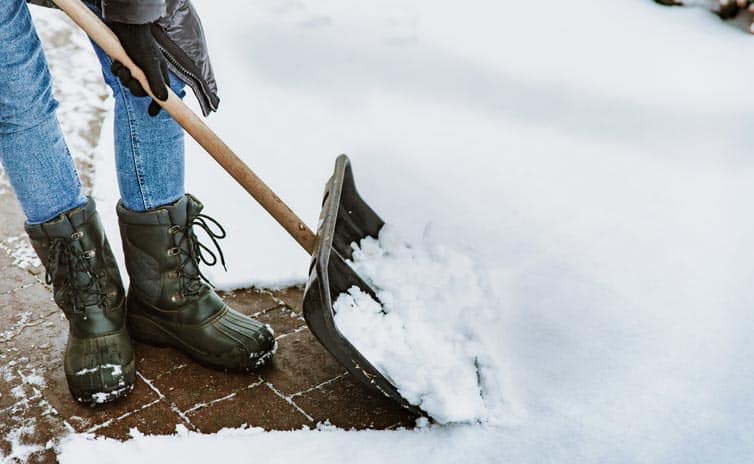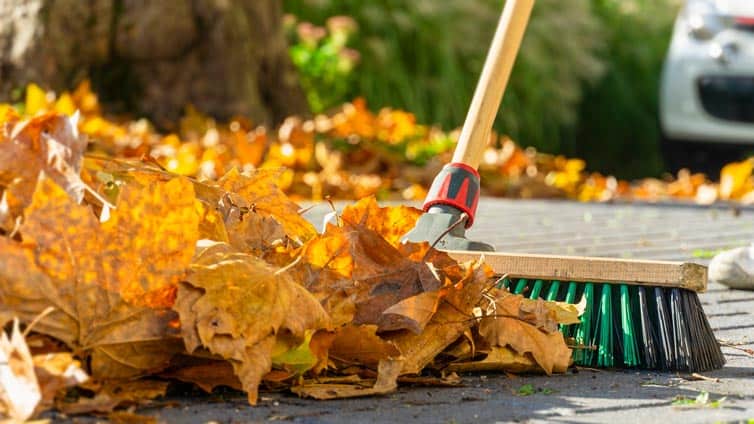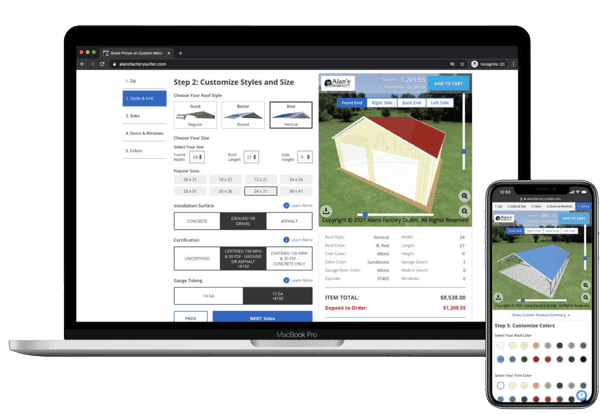Learn how to care for and maintain your concrete, asphalt, or gravel driveway all year round. Use these simple tips to keep your driveway in great shape.
When visitors arrive at your house, the first thing they see is your driveway. So you probably want it to look as nice as possible, right? Fortunately, there are some easy things you can do to maintain the appealing condition of your driveway. Here are some examples.
How to Maintain an Asphalt or Concrete Driveway
Keep it clean. One simple way to maintain the condition of your concrete driveway is to get out your broom to sweep once or twice a week. I consider it good exercise, and you can wave to your neighbors while you’re working!
If you have neglected your driveway for a while, power-washing can get rid of mildew and mold that may be on the surface.
Don’t change your car’s oil in the driveway. No matter how careful you are, there’s a good chance that you could spill oil.
Get rid of stains right away. You may move your car out of the driveway one day only to discover an oil stain. Cat litter can absorb oil and grease on concrete. You could also try to remove small stains with baking soda and a scrub brush. If it’s a large stain, you may want to buy some degreaser from the hardware store. Tree sap is another problem. It can be removed from asphalt with an alcohol-based hand sanitizer. For a concrete driveway you can use a petroleum-based hand cleaner like Goop.
Don’t put on too much weight. No, I’m not suggesting you need to go on a diet! Just don’t let anyone drive overweight vehicles on your driveway. Your driveway was designed to hold small residential vehicles, not fire trucks, concrete mixers, and huge moving vans. So make sure no one parks heavy equipment on your driveway.
Avoid scraping and scratching. Sharp points on the steel edge of your shovel can scrape and scratch the surface of concrete or asphalt. If you use a power washer on a setting that is too high, or if you use it to clean out cracks, it can also etch grooves into your driveway that will accelerate weathering processes.
Seal your driveway. Putting a sealant on your driveway can help to maintain its condition throughout the cold weather months. A sealant prevents melting snow from seeping into small cracks in a driveway. Sealant should be applied before the first winter, and every few years thereafter.
Get a carport. A carport provides a sheltered space for your vehicles, protecting them from the sun, rain, snow, and other harsh weather conditions. This reduces the wear and tear on your vehicles and minimizes the need for driveway repairs caused by weather-related damage. You can plan your carport with our 3D builder and learn more about metal carport prices.
Clear off snow. It’s a good idea to clear snow off your driveway before it has a chance to pile up. When snow starts to pile up, it can melt and refreeze as the temperature changes. Melting snow can seep into the small cracks in a driveway and refreeze when the temperature drops. As the frozen water expands, it creates deeper cracks and holes in a driveway’s surface.
If you get a dusting of snow that adds up to about an inch or two, you may be able to clean your driveway with a push broom. Cherish the opportunity to get rid of the snow on your driveway without touching a shovel!

A snow blower can come in handy if you want to avoid using a traditional shovel. There are a variety of snow blowers powered by either gas or electricity. With a snow blower, you can clear your driveway of snow in an efficient, timely way.
Before using a snow shovel, make sure your shovel is in good shape. A plastic shovel is safe to use, but a metal shovel with corners that are bent or crumpled up can scrape and damage the surface of a driveway. A snow shovel should have straight edges, and its corners should be intact. I recommend getting a new shovel if you have one that is starting to show signs of wear from previous winters.
Hiring a professional to clear away the snow on your driveway is a convenient way to get the work done. But be sure that the snowplow driver has the blade positioned at the right height. A snowplow blade that is too low can scrape against a cement driveway, creating cracks and holes and otherwise damaging the surface.
Avoid de-icers. De-icers contain chemicals such as ammonium nitrates that can sometimes leave stains behind or even cause chipping in concrete. De-icers also damage asphalt driveways. Using sand to improve the traction on an icy driveway is a good way to avoid this damage.
Avoid standing water. Standing water can cause a lot of damage to a driveway, especially when the water repeatedly thaws and refreezes. If water tends to pool on your driveway, you may have a drainage problem that needs to be fixed.
How to Maintain a Concrete Driveway
Use sand instead of salt. It’s tempting to throw rock salt on any patches of ice that you see on your driveway. But when this salt mixes with melting snow, it turns into a saltwater mush. This substance can leak into cracks in the driveway, freeze, and expand. This expansion can quickly turn a small crack into a large one that needs to be repaired in the springtime. Instead of rock salt, try sprinkling sand on your driveway. It doesn’t melt the ice, but it does supply traction when you need to get your car out of the garage.
Be careful with vinegar. Vinegar is a great natural cleaner, but it can wreak havoc on a concrete driveway if you aren’t careful. Vinegar can remove paint, oil, mold, and moss from your concrete driveway. But at the same time, vinegar degrades the cement that binds your concrete driveway together. So it should be used sparingly for quick spot treatments. Vinegar should not be left to sit on your driveway for extended periods of time
How to Maintain an Asphalt Driveway
An asphalt driveway takes a little more maintenance than a concrete driveway.
One tip for maintaining an asphalt driveway is to seal it every three to five years.
It’s also important to remove oil stains from asphalt. Put a commercial degreaser on the stain, rinse it with water, and sweep the mess away with a broom.

If cracks appear in the asphalt, it’s best to repair cracks immediately. Crack filler can be purchased at home improvement and hardware stores. First, you must clean the dirt out of the crack with a wire brush. Next, rinse it with water, let it dry, and apply the crack filler.
Over time, potholes can appear in an asphalt driveway due to changes in temperature. Fortunately, there are ways to fix potholes in a driveway. You can buy asphalt patch products to fill in these holes so they don’t damage your car tires or impact the overall condition of the driveway.
How to Maintain a Gravel Driveway
Rake up leaves and debris. Regularly raking up plant matter from your driveway help keep your driveway clean and looking nice. It also helps prevent slippery patches from developing.
Don’t plow it. A snow plow can make a big mess of a gravel driveway. Use a snow blower or a snow shovel instead.
Leave a small layer of snow on in the winter. You don’t need to remove every bit of snow from your gravel driveway. A little compacted snow on your gravel driveway provides enough traction for vehicles and foot traffic and the compacted snow also holds the gravel below in place.
Fix potholes. Spread some gravel into the pothole and use a compactor to compact one layer at a time, until the pothole is fixed. If you have a muddy spot that just swallows up gravel, you may need to dig out an area, lay down geotextile fabric to prevent the gravel from sinking into the mud, and then compact gravel on top.
Add fresh gravel. You should add a few inches of gravel every two to three years.
Consider permeable pavers. Permeable pavers are plastic grids that hold gravel in place. They can transform a loose gravel driveway into a solid surface that stays in place. You can use them to stabilize specific areas, or to hold your whole driveway in place.
If you follow these tips, you can keep your driveway working well and looking nice for a long time.




